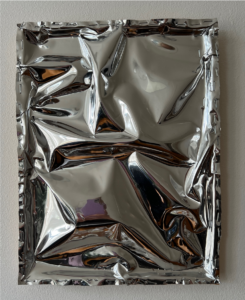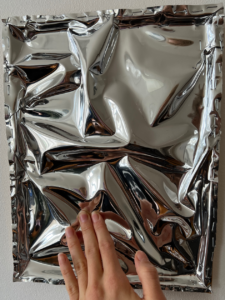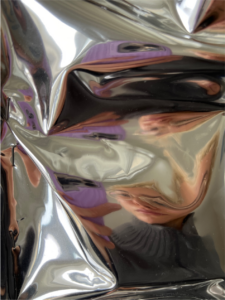by Alisha Archie




I Background
My project is inspired by and draws primarily from Sylvia Wynter’s (2003) “Unsettling the Coloniality of Being/Power/Truth/Freedom” and Franz Fanon’s (2008) “Black Skin, White Masks”. In the following, I will briefly introduce the core arguments of both works to provide a deeper context for the subsequent interpretation and artistic method of my artwork “Mirror for Nonwhite Peoples”.
I.I Sylvia Wynter (2003): “Unsettling the Coloniality of Being/Power/Truth/Freedom”
In “Unsettling the Coloniality of Being/Power/Truth/Freedom”, Sylvia Wynter (2003) argues that during the Renaissance, the West invented a new definition of what it means to be human which provided the foundational basis of modernity: While the definition of being human in the Middle Ages still centered around the church and distinguished “degrees of spiritual perfection/imperfection” (ibid.: 288) in humans, the West introduced a new “secular or ‘degodded’ […] mode of being human” (ibid.: 263) in the fifteenth and sixteenth centuries. This new descriptive statement of the human, Man, left Christian identity behind in favor of an understanding of “Man as political subject” (ibid: 280) and now defined the human by “degrees of rational perfection/imperfection” (ibid.: 288). The main threat to humanity was no longer defined in Christian logic as a legacy of the original sin, but instead secularly as a consequence of the irrational aspects of human nature. Submission to the authority of the political state and its goals (including territorial expansion in competition with other European states) was now presented as the only way to salvation (ibid.: 288-289).
Wynter (ibid.) argues that this redefinition, this new descriptive statement of the human, Man, was motivated by the needto find a justification for the colonization of the New World. Since the Indigenous peoples of the New World had never come into contact with Christianity, the European colonial powers could not categorize them as “Enemies-of-Christ” (ibid.: 293). This meant that the earlier theological systems used to legitimize imperial expansion could not be applied to the New World. In their search for a new system to legitimize colonialism, the European colonial powers invented a new category: race (ibid.: 296). Race then served the West to justify and rationalize the subjugation and dehumanization of the Indigenous peoples of the New World and the expropriation of their lands by inventing a “by-nature difference” (ibid.: 299) and inferiority of these peoples, portraying them as savage and irrational in contrast to the “civilized” and rational peoples of the West. In this way, the new descriptive statement of the human, Man, stripped the Indigenous peoples of the New World of their human status and continues to do so today for all non-Western, nonwhite peoples:
In the logic of the new descriptive statement of the human, Man, “the non-Western, nonwhite peoples can only, at best, be assimilated as honorary humans […] and, at the worst, must […] forcibly be proscribed from human status” (Wynter 2003: 329).
Wynter (ibid.) identifies that this new definition of the human invented by Western, white, bourgeois men is still overrepresented today as if it were the universal, “generic, ostensibly supracultural human” (ibid.: 288). This overrepresentation – which Wynter (ibid.) refers to as the Coloniality of Being/ Power/Truth/Freedom – makes it impossible for the peoples of the West to see non-Western and nonwhite peoples as human to this day:
“Seeing that once its ‘descriptive statement’ had been instituted as the only, universally applicable mode of being human, they [Westerners] would remain unable, from then on until today, of (to paraphrase Lyotard) conceiving an Other to what they call human” (Wynter 2003: 299; Lyotard 1990).
Wynter (2003) sees the greatest struggle of the 21st century and the key to solving the greatest problems of this millennium in overcoming this conception of humanity and thus unsettling the Coloniality of Being/ Power/Truth/Freedom.
I.II Franz Fanon (2008): “Black Skin, White Masks”
Wynter’s (2003) argument builds on Franz Fanon (among others) who in “Black Skin, White Masks” (2008) – focusing on the Black colonial experience, particularly in the Antilles where he grew up – recognizes through a self-reflective, psychological lens that the European colonial powers systematically erased and suppressed authentic Black identities and instead imposed racist, inferior identities on the colonized. A racist school and knowledge system further reproduced this imposition of inferior identities and led to the internalization of colonial ideologies by the Black colonized subject. As a result, many Black people under colonial rule struggled with an inferiority complex and self-hatred (Fanon 2008; Sardar 2008; Wynter 2003). Fanon (2008: 147) observes that it is “normal for the Antillean to be anti-Negro” and that the Black individual under colonial oppression often aspires to assimilate into whiteness. Consequently, Fanon advocates for the liberation of the Black colonized subject from “colonial cultural alienation” (Bhabha 2008: 16) and urges for a critical engagement with and dismantling of colonial ideologies to rediscover an authentic identity. He stresses the importance of not only accumulating knowledge but also being actional in bringing forth a new humanism and creating a new world (Fanon 2008: 1,173). In his conclusion, Fanon (ibid.: 179) therefore emphasizes that “the real leap consists in introducing invention into existence” – a sentiment echoed by Wynter in the closing line of her essay “Unsettling the Coloniality of Being/Power/Truth/Freedom”, where she affirms: “The buck stops with us” (Wynter 2003: 331).
II Interpretation
I have created a distorted Mirror for Nonwhite Peoples as a metaphor for the impossibility of seeing any nonwhite, non-Western person as human, which Sylvia Wynter (2003) has identified as embedded in the new descriptive statement of the human, Man. When you look at yourself in the Mirror for Nonwhite Peoples, it is impossible to see an undistorted image (of a human) no matter how you turn it, even though some shapes will resemble the actual human form more, others less. This reflects the varying degrees of humanity that our current descriptive statement of the human assigns to different nonwhite, non-Western peoples.
My artwork also represents a physical embodiment of the saying “holding a mirror up to someone” within the context of the nonwhite experience: When nonwhite people look in the Mirror for Nonwhite Peoples – bearing in mind that its use is exclusively intended for them – they can see the direct effect of the overrepresentation of the descriptive statement. Regardless of their efforts, the Mirror for Nonwhite Peoples fails to reflect their humanity. The Mirror for Nonwhite Peoples functions not only as a symbolic material manifestation of the racist logic of our current descriptive statement of the human but also as a practical tool for Black and nonwhite people to engage in (literal) self-reflection. It encourages them to engage with the Fanonian imperative to recognize and reject racially imposed identities while reclaiming authentic identities and culture. With my work, I want to promote the quest for disalienation (Fanon 2008: 174) and actively contribute to dismantling the overrepresentation of the West’s conception of humanity and unsettling the Coloniality of Being/Power/Truth/Freedom (Wynter 2003).
I deliberately chose a mirror – an object that is associated with femininity in our society – to reflect the intersection of race and gender, and particularly the special position of the Black woman in our society as well as in our conception of humanity. As the antithesis of the Western human ideal, the black woman has neither access to the world of the Black man nor the world of the white woman and finds herself on the lowest level of the human hierarchy (Fox 2006). Furthermore, the parallelization of associations that a mirror typically evokes and associations of stereotypical femininity – such as physical appearance, beauty and vanity – is also deliberately intended to point to Western beauty standards that favor whiteness and racialize and discriminate against nonwhite bodies. Women are disproportionately affected, as beauty as social capital tends to be more important for women compared to men (Hunter 2002). Western beauty norms and the connected devaluation and shaming of Black and nonwhite women’s bodies are directly rooted in slavery and the colonial project as a whole and continue to serve as instruments of both white supremacy and patriarchy today (Hunter 2002; Gqola 2010; Lakoff and Scherr 1984).
Ultimately, this project is also an introspective, autobiographical reflection on my own life as a Black woman growing up in a white family in a small conservative Bavarian town. Society has often figuratively held this symbolic Mirror for Nonwhite Peoples up to me, which I have now physically created: One that reflected my otherness, my supposed inadequacy as a human being, especially in the form of white beauty ideals that – despite all my efforts – I could never live up to. The cultural alienation, inferiority complex and self-hatred described by Fanon (2008) are therefore something I can personally identify with. Reading Fanon’s (ibid.) and Wynter’s (2003) work was an enlightening and profound experience for me overall. In this sense, the project – and the choice of a mirror as a means of (literal) self-reflection – is also very personal.
III Artistic Method
For the basic structure of my artwork, I repurposed a wooden tray reminiscent of the shape of a mirror. To achieve the result I envisioned, I then began to research and experiment with different materials – such as chrome paint, aluminum foil and real mirror fragments – as well as various techniques to create distortions, including layering and constructing substructures with papier-mâché. Eventually, I discovered a reflective silver “mirror fabric” that, when combined with a layering technique, produced the intended effect. Once my chosen method and materials were established, I experimented with my layering technique to achieve the desired distortions. The process of securing the fabric again required careful experimentation with attachment methods, ultimately resulting in the usage of a hybrid approach of staples and glue.
I intentionally left the fabric somewhat pliable so that it would remain flexible, yet always return to its original position after manipulation. This is meant to symbolize the doomed efforts of nonwhite peoples to be seen as human under our current definition of the human. Despite their best efforts, they are forever distant from reaching the white, Western human ideal – and forever distant from being seen as human. In this way, the artwork goes beyond the purely visual and offers a tangible demonstration and immersive experience of the impact of the new descriptive statement of the human, Man, and the struggle that nonwhite people face on a daily basis.
Finally, I have deliberately chosen to leave remnants of the fixture visible around the edges of the Mirror for Nonwhite Peoples as a poignant reminder that the new descriptive statement of the human, Man, is fabricated. By making the intentional manufacturing of the Mirror for Nonwhite Peoples obvious, I want to emphasize that our current definition of humanity and the resultant devaluation of non-Western, nonwhite peoples is not an inherent truth or irrefutable fact of nature, but rather a racist man-made construct devised by Western colonial powers.
IV Bibliography
Bhabha, Homi K. 2008. “Foreword to the 1986 Edition by Homi K. Bhabha.” in Black Skin, White Masks. Translated by C. L. Markham, edited by F. Fanon: Pluto Press.
Fanon, Frantz. 2008. Black Skin, White Masks. Translated by C. L. Markham: Pluto Press.
Fox, Patricia D. . 2006. “After Man, Womens: The Third Sex or Ain’t I a Eunuch.” Pp. 100-30 in After Man, Towards the Human: Critical Essays on Sylvia Wynter, edited by A. Bogues: Kingston, Jamaica: London: Ian Randle; Global [distributor].
Gqola, Pumla Dineo. 2010. What Is Slavery to Me? Postcolonial/Slave Memory in Post-Apartheid South Africa: Wits University Press.
Hunter, Margaret L. 2002. “”If You’re Light You’re Alright”: Light Skin Color as Social Capital for Women of Color.” Gender and Society 16(2):175-93.
Lakoff, Robin and Raquel Scherr. 1984. Face Value: The Politics of Beauty. Boston: Routledge & Kegan Paul.
Lyotard, Francis. 1990. Heidegger and the “the Jews“. Translated by A. Michel and Mark Roberts, with an Introduction by David Carroll. Minneapolis: University of Minnesota.
Sardar, Ziauddin. 2008. “Foreword to the 2008 Edition by Ziauddin Sardar.” in Black Skin, White Masks. Translated by C. L. Markham, edited by F. Fanon: Pluto Press.
Wynter, Sylvia. 2003. “Unsettling the Coloniality of Being/Power/Truth/Freedom: Towards the Human, after Man, Its Overrepresentation–an Argument.” CR: The New Centennial Review 3(3):257-337.
(Bhabha 2008, Fanon 2008, Fox 2006, Gqola 2010, Hunter 2002, Lakoff and Scherr 1984, Lyotard 1990, Sardar 2008, Wynter 2003)
V Appendix
Image 1: “Mirror for Nonwhite Peoples”
Image 2: Pliability – “Mirror for Nonwhite Peoples”
Image 3: Reflections & Distortions – “Mirror for Nonwhite Peoples”
Image 4: Perspective – “Mirror for Nonwhite Peoples”